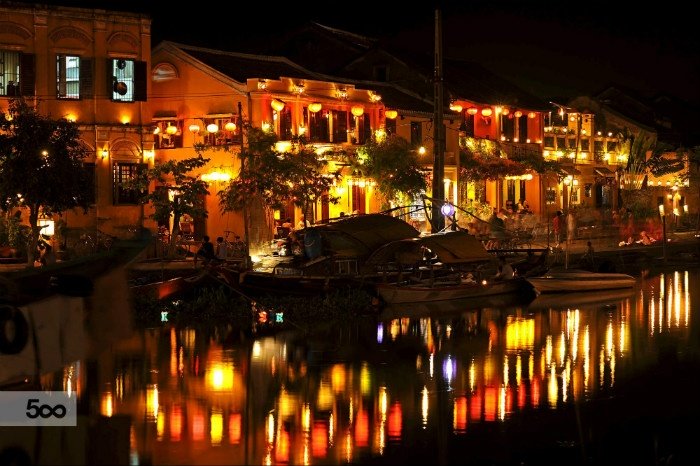
Hoi An – where life is so calm. Hoi An – where it seems that the flow of time inadvertently cannot bury the ancient atmosphere. The old roofs covered with moss, the streets flooded with the red of the lanterns, the elaborate frescoes, all brought us back to a world of a few hundred years ago. That is just a simple part in the old town of Hoi An but it is enough to make people fall in love and forget the way.
Hoi An Ancient Town is an ancient town located in the lower Thu Bon River, in the coastal plain of Quang Nam province, about 30km south of Danang city.
The ancient town of Hoi An is encapsulated in Minh An ward with an area of only about 2 km2 with a very special terrain in the style of a chessboard that is characterized by short and narrow roads, running winding, horizontal and vertical, causing people to Whichever way we turn, it’s easy to meet each other.
According to Hoi An statistics, there are 1360 relics including 1068 ancient houses, 11 ancient wells, 38 ethnic churches, 19 temples, 43 temples, 23 communal houses, 44 special ancient tombs and a bridge. Despite the space and time to move, Hoi An ancient town retains the most ancient beauty. It is like a place where one can find a relic population preserved almost intact, making Hoi An a unique place in the annals of modern times.
Coming to Hoi An today, it is as if we are going back in time, straying in the traditional atmosphere of a busy trading port in the Nguyen Dynasty. Coming to Hoi An today is able to leave all the temptations of everyday life to live fully in every moment.
HOI AN ASSEMBLY, VISIT THE YEAR-OLD CHAIRS YEARS OLD YEARS OLD
The temples built from the middle of the 17th century to the middle of the eighteenth century are one of the attractive destinations in the ancient town of Hoi An. That is Ba Pagoda, Ong Pagoda, Chuc Thanh Pagoda, Phuoc Lam Pagoda, Van Duc Pagoda, and Hai Tibet Pagoda.
Most of the pagodas in Hoi An were built to worship the fairies, the people who founded the town, the guild and the Minh Huong commune. Therefore, it is common to see a typical architectural style with refractory brick walls, yin-yang tile roofs and the altar placement in the middle compartment. He is also known as Quan Cong Temple, the temple is located on the corner of Tran Phu Street intersecting Nguyen Hue Street, which is considered a monument typical of the temple architecture style of Minh Huong people in Hoi An.
Quan Cong Temple is also considered a religious center of Hoi An merchants and for that reason, to this day, every 13 January and 24 June of the lunar calendar every year, the festival of Ong Pagoda is The organization attracts a lot of tourists to gather.
But what makes people most impressive is the Covered Bridge, the temple is famous for its strange architecture that forms an icon of Hoi An temple temple. Japanese Covered Bridge, also known as Japanese temple, was built in Japanese style but after many renovations, people realized it became more and more Vietnamese-Chinese culture.
Cau pagoda is about 18m long, covered by a roof, made of wood with lacquered lacquered paint, curved and curved across the creek running to the Thu Bon river, connecting Tran Phu and Nguyen Thi Minh Khai streets. The pagoda does not have a Buddha image, but in the main time, there is a wooden statue of the North Emperor Tran Vo as expressing the aspiration for happiness, joy of people of the ancient people of Hoi An.